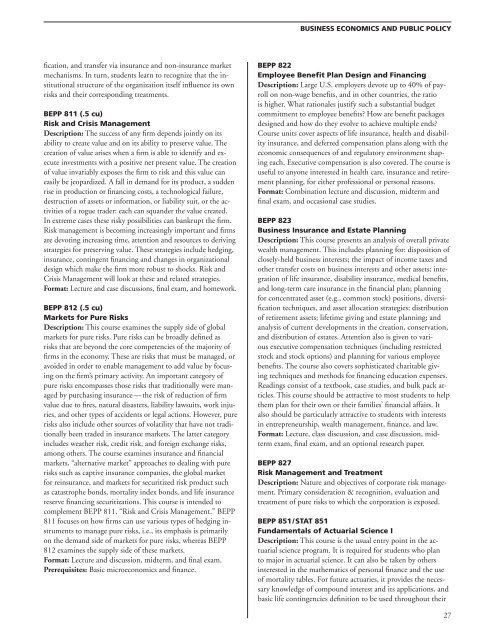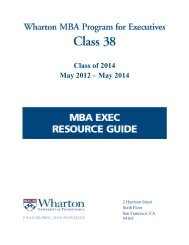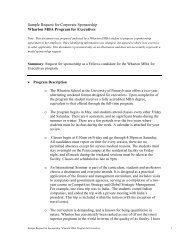Explore Options; Plan Your MBA Academic Program
Explore Options; Plan Your MBA Academic Program
Explore Options; Plan Your MBA Academic Program
You also want an ePaper? Increase the reach of your titles
YUMPU automatically turns print PDFs into web optimized ePapers that Google loves.
fication, and transfer via insurance and non-insurance market<br />
mechanisms . In turn, students learn to recognize that the institutional<br />
structure of the organization itself influence its own<br />
risks and their corresponding treatments .<br />
BEPP 811 ( .5 cu)<br />
Risk and Crisis Management<br />
Description: The success of any firm depends jointly on its<br />
ability to create value and on its ability to preserve value . The<br />
creation of value arises when a firm is able to identify and execute<br />
investments with a positive net present value . The creation<br />
of value invariably exposes the firm to risk and this value can<br />
easily be jeopardized . A fall in demand for its product, a sudden<br />
rise in production or financing costs, a technological failure,<br />
destruction of assets or information, or liability suit, or the activities<br />
of a rogue trader: each can squander the value created .<br />
In extreme cases these risky possibilities can bankrupt the firm .<br />
Risk management is becoming increasingly important and firms<br />
are devoting increasing time, attention and resources to deriving<br />
strategies for preserving value . These strategies include hedging,<br />
insurance, contingent financing and changes in organizational<br />
design which make the firm more robust to shocks . Risk and<br />
Crisis Management will look at these and related strategies .<br />
Format: Lecture and case discussions, final exam, and homework .<br />
BEPP 812 ( .5 cu)<br />
Markets for Pure Risks<br />
Description: This course examines the supply side of global<br />
markets for pure risks . Pure risks can be broadly defined as<br />
risks that are beyond the core competencies of the majority of<br />
firms in the economy . These are risks that must be managed, or<br />
avoided in order to enable management to add value by focusing<br />
on the firm’s primary activity . An important category of<br />
pure risks encompasses those risks that traditionally were managed<br />
by purchasing insurance — the risk of reduction of firm<br />
value due to fires, natural disasters, liability lawsuits, work injuries,<br />
and other types of accidents or legal actions . However, pure<br />
risks also include other sources of volatility that have not traditionally<br />
been traded in insurance markets . The latter category<br />
includes weather risk, credit risk, and foreign exchange risks,<br />
among others . The course examines insurance and financial<br />
markets, “alternative market” approaches to dealing with pure<br />
risks such as captive insurance companies, the global market<br />
for reinsurance, and markets for securitized risk product such<br />
as catastrophe bonds, mortality index bonds, and life insurance<br />
reserve financing securitizations . This course is intended to<br />
complement BEPP 811, “Risk and Crisis Management .” BEPP<br />
811 focuses on how firms can use various types of hedging instruments<br />
to manage pure risks, i .e ., its emphasis is primarily<br />
on the demand side of markets for pure risks, whereas BEPP<br />
812 examines the supply side of these markets .<br />
Format: Lecture and discussion, midterm, and final exam .<br />
Prerequisites: Basic microeconomics and finance .<br />
BUSINESS ECONOMICS AND PUBLIC POLICY<br />
BEPP 822<br />
Employee Benefit <strong>Plan</strong> Design and Financing<br />
Description: Large U .S . employers devote up to 40% of payroll<br />
on non-wage benefits, and in other countries, the ratio<br />
is higher . What rationales justify such a substantial budget<br />
commitment to employee benefits? How are benefit packages<br />
designed and how do they evolve to achieve multiple ends?<br />
Course units cover aspects of life insurance, health and disability<br />
insurance, and deferred compensation plans along with the<br />
economic consequences of and regulatory environment shaping<br />
each . Executive compensation is also covered . The course is<br />
useful to anyone interested in health care, insurance and retirement<br />
planning, for either professional or personal reasons .<br />
Format: Combination lecture and discussion, midterm and<br />
final exam, and occasional case studies .<br />
BEPP 823<br />
Business Insurance and Estate <strong>Plan</strong>ning<br />
Description: This course presents an analysis of overall private<br />
wealth management . This includes planning for: disposition of<br />
closely-held business interests; the impact of income taxes and<br />
other transfer costs on business interests and other assets; integration<br />
of life insurance, disability insurance, medical benefits,<br />
and long-term care insurance in the financial plan; planning<br />
for concentrated asset (e .g ., common stock) positions, diversification<br />
techniques, and asset allocation strategies; distribution<br />
of retirement assets; lifetime giving and estate planning; and<br />
analysis of current developments in the creation, conservation,<br />
and distribution of estates . Attention also is given to various<br />
executive compensation techniques (including restricted<br />
stock and stock options) and planning for various employee<br />
benefits . The course also covers sophisticated charitable giving<br />
techniques and methods for financing education expenses .<br />
Readings consist of a textbook, case studies, and bulk pack articles<br />
. This course should be attractive to most students to help<br />
them plan for their own or their families’ financial affairs . It<br />
also should be particularly attractive to students with interests<br />
in entrepreneurship, wealth management, finance, and law .<br />
Format: Lecture, class discussion, and case discussion, midterm<br />
exam, final exam, and an optional research paper .<br />
BEPP 827<br />
Risk Management and Treatment<br />
Description: Nature and objectives of corporate risk management<br />
. Primary consideration & recognition, evaluation and<br />
treatment of pure risks to which the corporation is exposed .<br />
BEPP 851 / STAT 851<br />
Fundamentals of Actuarial Science I<br />
Description: This course is the usual entry point in the actuarial<br />
science program . It is required for students who plan<br />
to major in actuarial science . It can also be taken by others<br />
interested in the mathematics of personal finance and the use<br />
of mortality tables . For future actuaries, it provides the necessary<br />
knowledge of compound interest and its applications, and<br />
basic life contingencies definition to be used throughout their<br />
27

















